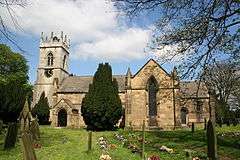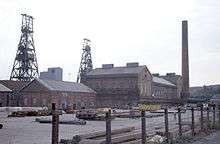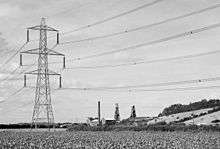Rossington
| Rossington | |
 St Michael's church |
|
 Rossington |
|
| Population | 13,255 |
|---|---|
| OS grid reference | SK624981 |
| Civil parish | Rossington |
| Metropolitan borough | Doncaster |
| Metropolitan county | South Yorkshire |
| Region | Yorkshire and the Humber |
| Country | England |
| Sovereign state | United Kingdom |
| Post town | DONCASTER |
| Postcode district | DN11 |
| Dialling code | 01302 |
| Police | South Yorkshire |
| Fire | South Yorkshire |
| Ambulance | Yorkshire |
| EU Parliament | Yorkshire and the Humber |
| UK Parliament | Don Valley |
Coordinates: 53°28′33″N 1°03′41″W / 53.47594°N 1.06130°W
Rossington is a civil parish and former mining village in the Metropolitan Borough of Doncaster in South Yorkshire, England and is surrounded by countryside and the market towns of Bawtry and Tickhill.
Geography
It has a population of 13,255.[1] Robin Hood Airport Doncaster Sheffield is around two miles to the east. The village is demarcated to the north and west by a line of 400 kV pylons, as seen from the M18, to the north. The Finningley and Rossington Relief Road Scheme - from Junction 3 of the M18 to Parrot's Corner (junction of the A638 and the B6463 roads) - is proposed to allow access to the airport. Construction was due to start in late summer 2012 though initial site clearance work only commenced in early 2013 .[2][3]
To the north-west, the village borders Loversall, with the boundary following the River Torne, passing directly next to the western edge of the former Rossington Main Colliery. It briefly crosses the M18 at the point where the motorway crosses the East Coast Main Line. At this point it meets the Borough of Doncaster and follows Mother Drain, then the River Torne, north of Torne Valley Farm. It passes by a Roman fort and crosses the A638 at Rossington Bridge, north of Rossington Bridge Farm. At Wheatcroft Farm it meets Finningley. Nearby at the junction of the A638 and B6463, there is a park and ride car park. The boundary passes along the west of Hurst Plantation, and meets the A638, a former Roman road, at Warren House Farm. Following the A638 at Mount Pleasant Hotel, it meets Austerfield. In the south-east of the parish is the Northern Racing College (for horse racing), next to Rossington Hall School. At Bawtry Forest, it meets Bawtry. Crossing the B6463 at New England Cottages, it meets Tickhill. At Stancil Bridge, it meets the River Torne and Wadworth.
Places of worship
The village has a number of churches of different denominations: St. Michael's Church (Rossington Parish Church); St. Lukes's Church (New Rossington Parish Church); Rossington Methodist Church; Christ The King Roman Catholic Church; New Life Christian Centre; and Rossington Community Baptist Church at Holmescarr Community Centre
Education
The village has several schools, including: St. Michael's CE Primary School; St. Joseph's RC Primary School; Tornedale Infant School; Pheasant Bank Junior School; Grange Lane Infant School; and Rossington All Saints Academy. Rossington Hall, which became a boarding school for "educationally subnormal" children in 1953, closed in 2008.[4] Former councillor and Labour Party politician Caroline Flint owned 77 acres on the 3,000 acre Rossington Hall site in 2008.[5]
History
There are remains of both a Roman fort and Roman pottery kilns in the area. The name Rossington translates from the old Anglo-Saxon name of 'Farm on the Moor'. In later times, Rossington housed a small village and both Rossington Hall and Shooters Hill Hall. Until the reign of Henry VII, the Rossington area was in Nottinghamshire as the River Torne was part of the boundary between Yorkshire and Nottinghamshire.
Rossington villages
The area known as "Rossington" is made up of a number of villages and hamlets, namely "Hesley", "Littleworth", "Rossington", "New Rossington", Rossington Bridge and Shooters Hill. Littleworth was enlarged to a great degree in the 1970s, when Littleworth Park Estate was built. The New Village began to be built around the time of the sinking of the Colliery. Rossington Bridge, although now only consisting of a few buildings is the oldest of the four settlements; situated on the crossing of the Roman road from Lincoln (Lindvm) to York (Ebvrscvm) via Doncaster (Danvm) it was once the site of a major Roman fort (the largest between Lincoln and York). Rossington Bridge was also an important staging post on the Great North Road.
In more recent years, Rossington has seen the building of large levels of new, private housing, particularly around the "Old Village", raising the village's affluence. Locally, the village is known as "Old Village" and "New Village" but local estate agents use the term "Old Rossington" when actually referring to the "Old Village."
Colliery

It was, however in the mid-twentieth century that saw the largest expansion of the area. The pit was sunk between 1912 and 1915 The need for workers in and around the Rossington Main Colliery led to the building of large numbers of houses near to the pit in what was called New Rossington. After the end of British Coal in the early 1990s, the mine was able to keep operating and became one of the last in the area to keep producing coal albeit at a greatly reduced scale. However, with the decline of the mine, the village suffered high levels of unemployment and poverty throughout the 1990s and early 2000s. The Colliery closed briefly between 1993 and 1994 before finally closing in 2007. In 2012 a coal reclamation project started on the Rossington Colliery spoil tip, this is expected to take up to 5 years to complete.
In September 2012 planning permission was given by the borough council to build a £100 million, 1,200 home, housing development including a primary school and hotel on the colliery site.[6] Construction of houses on the site began in May 2015.[7]
Rail transport
The 'Old Village' and 'New Village' are separated by the East Coast Main Line; there are only two crossing points over the railway between the old and new villages. These are the road bridge on Stripe Road and the level crossing at the point where West End Lane becomes Station Road. Rossington railway station was closed for regular services in 1958 but a few special trains stopped there until the late 1960s. The station buildings and platforms remained in place until the early 1980s, when the platforms, which were to the south of the level crossing were dug up and the old signal box that stood on the north east side of the crossing was demolished. The signalling having been automated and control of the crossing moved to Doncaster PSB a few years before. When the old signal box was in operation the crossing was controlled by a large set of wooden gates, which were operated by the signalman who had to leave the signal box and open and close the gates by hand. By the mid 1950s these gates were opened and closed by a large wheel in the signal box. These gates were replaced by automated barriers controlled from Doncaster PSB at the same time as the signal box was closed; however, some older residents of Rossington still refer to the crossing gates. The only surviving building is the old Station cottages, which stand on the north west side of the crossing and are now private dwellings.
Rail Port

In the first decade of the twenty first century a plan was proposed for an 'eco town' of over ten thousand homes, to the southwest of Rossington, the plan was opposed by the majority of Rossington residents, and was reduced in scope by the end of the decade; a related industrial development proposed as part of the plan was a large scale intermodal rail terminal which received wider support and was given planning consent in 2011 with construction expected to take place over two years starting 2012, with continued development over eight years. The rail terminal is to be built west of the Rossington Colliery site.
Sport
Rossington Main Football Club was formed in 1919 as Rossington Colliery, originally playing behind the Colliery offices in New Rossington, before moving to their current home at the end of Oxford Street in 1921. In 1998 the club merged with the latterly formed Rossington FC (formerly Station FC), and the new Rossington Main F.C. currently play in the Northern Counties East League.
Rossington is the home to the 'RASCALS' swimming team based at Rossington Sports Centre. Rossington Swimming Club was founded in June 1966.[8]
Rossington has a long history of local junior and senior cricket. Rossington Main Cricket Club. The Cricket Club has 3 Senior teams that mixes youth and experience and these teams play on a Saturday and Sunday. The Cricket Club also has junior teams from the age ranges under 11's, under 13's, under 15's and under 17's.[9]
Notable people
- Don Concannon, Labour MP from 1966-87 for Mansfield (another area with coal mining heritage)
- Ernest Jones CBE, President from 1954-60 of the NUM, worked at Rossington Main Colliery from 1918–21
|
References
- ↑ Office for National Statistics : Census 2001 : Parish Headcounts : Doncaster Retrieved 27 August 2009
- ↑ "Work to start on £56m Finningley and Rossington link road". BBC. 24 August 2013. Retrieved 13 November 2015.
- ↑ "Summer Start for Airport Link Road". The Star. 13 April 2011. Retrieved 13 November 2015.
- ↑ Torrance Mendez (28 June 2013). "Generous doctor gave his all to his patients". The West Australian. p. 97.
- ↑ Tom Peterkin (15 May 2008). "Labour: Housing Minister Caroline Flint accused of eco-town cronyism". Daily Telegraph. p. 8. Retrieved 22 December 2013.
- ↑ "Plans for 1,200 homes on Rossington colliery approved". BBC. 4 September 2012. Retrieved 5 January 2014.
- ↑ "Work starts on housing scheme at Rossington colliery site". BBC News. 6 May 2015. Retrieved 14 May 2015.
- ↑ "Rossington Swimming Club". Retrieved 5 January 2014.
- ↑ "Rossington Main CC". Rossington MCC. Retrieved 13 November 2015.
External links
| Wikimedia Commons has media related to Rossington. |
- Northern Racing College
- Friends of Rossington (Facebook Page)
- Friends of Rossington (website)
- Old Rossington Photos (Facebook Page)
- Rossington Village Life (website)
| ||||||||||||||||||||||



